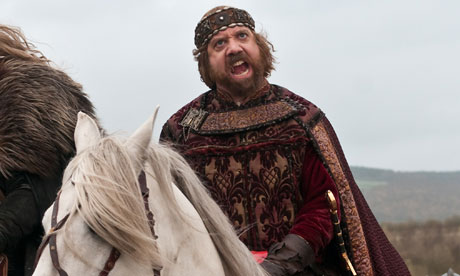
Ironclad (2011)
Director: Jonathan English
Entertainment grade: D+
History grade: Fail
In 1215, King John of England was forced by his barons to sign a charter of liberties, Magna Carta. Afterwards, civil war broke out.
Military orders
King John (Paul Giamatti) arrives at a castle in which fictional Templar knight Thomas Marshall (James Purefoy) is staying. The film makes a big deal out of the supposedly deathly rivalry between John and the Templars. There wasn't one. The real John awarded the Templars special privileges, including exemption from all taxation and extraordinary protection of their property. In 1215, when this movie is set, the Templars let John use their headquarters, the New Temple in London, as a treasury. He stayed there often, and stored the crown jewels and his top-secret documents there. Ironclad has this entirely wrong. Perhaps you can't have a medieval movie these days without a badass Templar. Blame The Da Vinci Code.
Violence
After John murders his companions, Marshall hooks up with real-life rebel William d'Aubigny, Lord of Belvoir (Brian Cox). They assemble a posse of earthy vagrants to stop John at Rochester Castle on the Medway. Royal forces attack. Somebody gets sliced in half from shoulder to navel. Somebody else gets whacked with the soggy end of a severed arm. Elbows, legs and heads spray blood. It splatters across the camera lens – which would be fine in a computer game, but is weird in a feature film. Is the viewer supposed to mistake Ironclad for a documentary?
Unlikely, seeing as it can't get even the basic facts right. When the royal forces are beaten back, John hisses: "What I am having trouble with is how 1,000 men could have failed so miserably against 20." They didn't. There were at least 95 knights and 45 men-at-arms defending Rochester Castle, not 20 vagrants.
People
John attacks with a siege tower, which the rebels blow up by firing back with a flame-throwing trebuchet. "Do not record that!" the king screams, ripping pages out of the royal chronicler's hands. Possibly, this is a feeble attempt to excuse Ironclad's inaccuracies. They're piling up higher than the battlements.
John's forces break through the outer castle wall, driving the rebels into the keep. Aubigny is captured. John hacks off his hands and feet, before strapping him into the trebuchet and flinging him against the castle wall. Utter nonsense. In real life, Aubigny survived the siege of Rochester Castle with his life and all appendages intact. He was imprisoned, then ransomed out for 6,000 marks. By 1217 he fought for John's son and heir, Henry III. He died two decades later of non-trebuchet-related causes.
Warfare
John's engineers dig a mine beneath the rebel-held castle keep and herd fatted pigs into it. Then they set a fire. The pigs squeal and burn, fuelling the flames that incinerate the wooden struts holding up the mine. It collapses – as does the stone keep wall above. Behold: the castle-busting medieval pig-bomb. Seems crazy? Actually, this bit is true. Almost. John did order "40 fat bacon-pigs, the least good for eating" for the mine, but the chronicles say only that the fat from the pigs was used to lard the mine's wooden struts – not that live pigs were set on fire.
Victory
Royal forces storm the keep. Just as the rebels' last stand is about to fall, reinforcements gallop to their rescue. It's Prince Louis of France, come to claim victory for the rebels! Not a moment too soon! Except, in real life, it is about six months too soon. The siege of Rochester ended with a rebel surrender on 30 November 1215. Prince Louis did not land in Kent until 21 May 1216. But Ironclad wants a happy ending, so its siege of Rochester ends … with the defeat of King John.
What? It can't do that! As historian Alan Lloyd commented, King John's famous victory at Rochester "ranked with the relief of Mirebeau among his more spectacular military achievements". Next, from the team that brought you Ironclad: 1815 – Napoleon's glorious triumph at Waterloo; 1942 – Hitler conquers the Soviet Union; 1973 – the Americans win in Vietnam.
Verdict
Somebody should have exploded a pig-bomb beneath this catastrophic movie.

